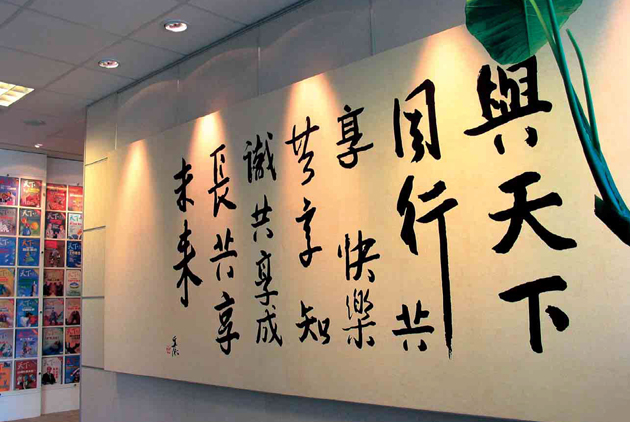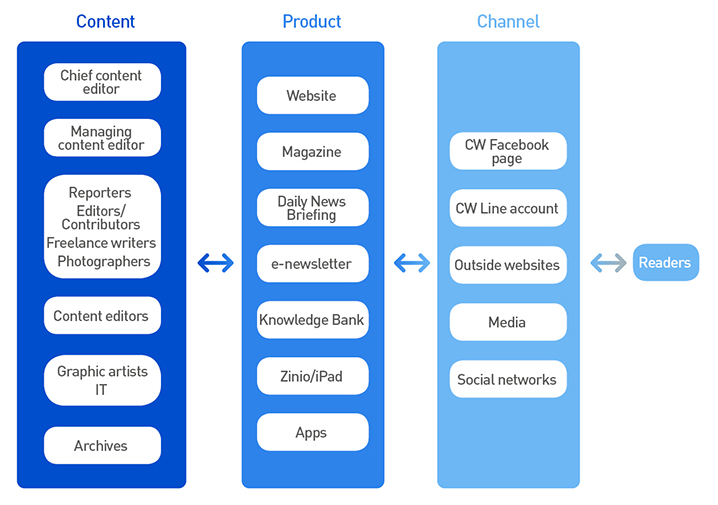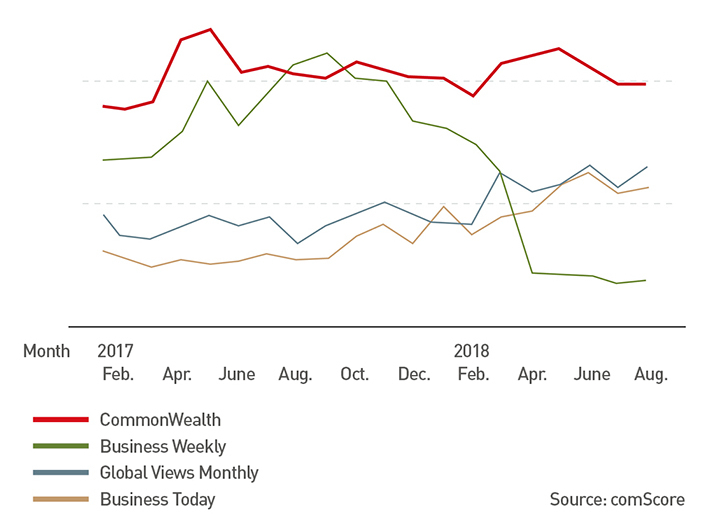CommonWealth Magazine Digital Transformation Report
The Print vs. Digital Dilemma

Source:CW
The most difficult part of going from developing print content to integrating print and online content was combining different processes and work routines. To overcome the problem, CommonWealth adopted a “Central Kitchen” concept that relies on an editorial team to rework content and then reuse it through multiple channels.
Views
The Print vs. Digital Dilemma
By CommonWealth Magazineweb only
The digital economy has upended every industry, and the media is no exception. But while international media outlets have been overhauling their operations to adapt to the changing world, the business models of most Taiwanese media organizations have remained stagnant.
At a time when most media organizations were stuck contemplating the dilemma of offline vs. online digital content, the enterprising Diane Ying boldly announced CommonWealth’s digital goal for 2017: the introduction of a digital content subscription service.
But this digital transformation was harder and more complicated than anybody had imagined.
Challenge No. 1:
Print-Web Integration
The most difficult part of going from developing print content to integrating print and online content was combining different processes and work routines. To overcome the problem, CommonWealth adopted a “Central Kitchen” concept that relies on an editorial team to rework content and then reuse it through multiple channels.
Getting the editorial department on the same page was particularly challenging. It required integrating content from different platforms through one editorial desk that had to satisfy the specific needs and preferences of each CommonWealth channel, hence the “Central Kitchen: One Source, Many Uses” approach.
Traditional media outlets have tended to go digital by dividing their editorial departments into separate print and online teams. CommonWealth, however, opted for a single content team that pools stories, photos and videos on one platform. Print and online editors then select what they need and repackage it for the appropriate channel to reach targeted audiences.
By making the most effective use of manpower and introducing efficient processes, this Central Kitchen system has ensured maximum exposure and impact for all of the content generated.
The ‘Central Kitchen’ for CommonWealth’s Editorial Content

Designing such a process had four main benefits, according to Joyce Cheng, CommonWealth’s chief of digital content operations.
-
Aligning the quality of both print and digital content: Aside from writing stories for the magazine, CommonWealth reporters also produce copy for the website. Having content generated by the same group of writers ensures that print and digital content meet the same high standard of quality. But when the work for one channel increases, work for the other must inevitably decrease, which results in editors selecting online content for publication in the magazine. This reflects a “first digital, then print” approach adopted by the company.
-
Lengthening magazine production times and spreading out the workload to learn new skills: After the print and online operations were integrated, the editorial department had to adapt to a new work routine in which stories are filed and posted online on a daily basis.
To compensate, work on the magazine in the week before its publication date was limited to designing the cover story presentation. This helped reduce overtime and freed up time to provide digital skills training to editors who were focused solely on the print magazine.
At the same time, story editors learned how to write headlines for digital stories and plan special digital series. This represented a dramatic change from how editorial tasks were done in the past.
-
Writing with the user in mind: When everyone knows the content they produce will not only reach CommonWealth’s standard target audience but also be used by other channels, the content, selection, and design processes will inevitably change. Netizens wanted more depth, while the magazine needed more down-to-earth content that connected with the average reader. The only difference became the window through which readers access the content.
-
Developing more products: Beyond the website and magazine, several other products such as a daily newsletter and app were created that can also rely on stories, photos, and videos selected, repackaged and reused by the editorial desk.

Step One: Changing How Reporters Do Their Job
The real difficulty of print-online integration was figuring out how the old organization could respond to new demands and how the new processes could achieve their anticipated benefits.
In 2015, the editorial desk took the first step in its digital transformation by holding early meetings. Every morning at 9:30 a.m., people from every beat get on Slack (an online team communication platform) and report to Managing Editor Sara Wu.
If there are important developments on particular beats, stories for the website are first planned, and a story budget is developed. The Monday editors meeting and the 9:30 a.m. meetings held every Tuesday to Friday have been held without interruption for the past four years. Wu speaks and walks fast, as if trying to keep up with the fast pace of the industry.
CommonWealth Magazine is published once every two weeks, and reporters were initially skeptical about holding morning meetings and weekly deadlines. The typical routine for the magazine’s reporters was to divide up the coverage after a topic was identified every two weeks and then submit stories weeks or even months later.
Reporters could organize their time as they saw fit without having to come into the office every day. Now, they have to get up early every morning, report the stories they’re working on, and attend meetings, a huge change from their original routines.
In 2017, before the digital content subscription service went online, it was determined that the number of digital stories had to be increased. The original directive of only writing a website story if something major happens was changed to a quota of at least one internet story per person per week.
Reporters rebelled, asked such questions as: “Will this help us beat out newspapers?” “Why are we fighting a hopeless battle?” and “I came here to do in-depth reporting. Why should I have to write stories for the internet?”
Unlike new media, CommonWealth Magazine wanted to maintain the quality of its print operation while pursuing real-time online news, but trying to do both was a big challenge. After several discussions, the editorial department defined stories for the website as “instant interpretations of the news”.
That meant text of at least 1,000 Chinese characters with a clear angle and verification from more than one source.
One example was coverage of the dispute between National Taiwan University President-elect Kuan Chung-ming and the Ministry of Education. The ministry on May 4 rejected Kuan’s appointment due to alleged conflict of interest and other irregularities after he was elected to the post by a university election committee in early January.
CommonWealth was first to write the story of three businesspeople supporting Kuan on January 5, the day he was elected, and over the next five months, three reporters on the politics and economics beat wrote 16 news analyses of more than 2,000 characters each under the direction of Deputy Managing Editor Rebecca Lin.
While online stories were positioned as “instant in-depth analysis”, the cover stories of the print version of the magazine continued to feature special reports prepared for more than a month, focusing on major social issues.
With CommonWealth’s editorial department active in both the digital and print realms, coordinating the varying demands the two models put on manpower, time, and content generation required more effective internal management and standard operating procedures.
Step Two: Maximizing Both Quality and Clicks
Of equal concern was the adoption of a paywall. The fear was that the paywall would block reader access to articles and precipitate a serious decline in web traffic, which in turn would adversely affect advertiser interest.
There are different kinds of paywalls. Under a “hard paywall”, all of the site’s content requires payment except for headlines and the first few lines of those stories. The Times of London adopted a hard paywall in 2010, and its web traffic fell by 66 percent.
CommonWealth decided instead on a “metered payroll”, which allows readers access to a small number of articles for free before charging for access to additional content. There were two advantages to this approach over a hard paywall. First, the more than 40,000 articles accumulated over CommonWealth’s 37-year history would still be available within the quota of free articles and could still be promoted through social media, enabling more readers to see them. Second, readers could read a few articles in full before subscribing, generating both web traffic and revenue.
But there was also risk. Soon after the New York Times and the Economist put in metered paywalls, traffic fell 10-20 percent from when their website content was free.
Yet in the six months after CommonWealth launched its paywall in March 2017, web traffic not only did not fall but actually continued to rise, relieving the unease many felt over the potentially risky strategy.
CommonWealth Web Traffic Still Higher than When Paywall Launched

The Key to That Success Was the Quality of CommonWealth’s Online Reporting.
“Articles with a lot of clicks may not necessarily have a lot of influence, but articles without many hits won’t have any influence because nobody is sharing them,” says CommonWealth Managing Editor Sara Wu.
In the internet age, veteran reporters have an edge, but once articles are posted online and exposed to critical audiences, the work of younger reporters with fresh angles and ideas can also draw readers.
At the end of 2017, Felice Wu was transferred from her position as a researcher in CommonWealth’s Survey Center to the editorial department. (Read her work: The Mazu Pilgrimage Experience)
Yet to turn 30, Wu drew on her data analysis skills to comb through that year’s income tax filing data and write a story on the “Wealthiest of the Wealthy”, describing the kinds of people living in Taipei’s highest income bracket.
The story received nearly 100,000 clicks soon after it was posted, and Wu was promoted to reporter within a month after that.
“The key is exclusives, not experience. As long as your skills are competitive, you can do it,” says Sara Wu, citing the example to encourage young reporters.
Another pillar driving traffic is in-depth news analysis in real time, which supplements an element missing from a semi-monthly magazine.
Because CommonWealth Magazine is published every two weeks, it inevitably is beaten to the punch by more agile weekly magazines whenever something big happens unexpectedly. There is also the risk that posting something online first will compromise the interest of readers of the magazine, leaving editors unsure what to do. After the launch of the paid subscription service, however, reporters were able to post cover story-like reports online whenever warranted.
The best example of this came in May of 2018, during Malaysia’s general elections. Taiwanese readers have generally shown little interest in Southeast Asian political or economic issues, but the editorial department decided to send reporters to Malaysia ten days before the election was held.
To everyone’s surprise, former Prime Minister Mahathir Mohamad emerged victorious, leading to many dramatic story angles. “Malaysia’s new 93-year-old prime minister,” the “revenge of the king,” and “turning defeat into victory” were just some of the themes bandied about, driving interest in what would have normally been just another hardcore political news story.
On election night, CommonWealth was the first Taiwanese media outlet to provide real-time analysis, and it followed that with an in-depth online special report featuring several articles. The main article in the series drew nearly 80,000 hits in the next two to three days.
A week later, a special report on Mahathir’s victory appeared in the print version of CommonWealth Magazine after some reworking and repackaging of the original articles. The print version of the special feature then gained additional exposure when posted online, further expanding the coverage’s reach.
Similarly, a series of six articles on a dissertation scandal at National Taiwan University by Deputy Managing Editor Liang-Rong Chen that was published in April 2017 received 420,000 hits online, more than the circulation of any magazine in Taiwan.

Hits and Orders – the Print vs. Digital Dilemma
Speed may be the key to digital media getting hits, but exclusive, in-depth content is what counts when determining whether readers are willing to fork out money for an online subscription. This tug-of-war between speed and quality has become a source of consternation for print-era reporters trying to adapt to the digital world.
In the past, most articles would be hard put to get a few dozen letters from readers within a month after the magazine was published. In today’s digital world, however, articles can get as many as 10,000 hits and at least a few hundred hits within hours of being posted online.
The market is now completely dictated by numbers – they make it immediately clear whether a topic or a story angle resonates or not – putting reporters under pressure. Those numbers are projected on screen and reviewed at the weekly editors meeting on Monday.
Deputy Managing Editor Chen Yi-shan has felt the pressure of number-watching first hand. She is responsible for the pariah of internet news content – the financial beat.
The financial news section does not have any star CEOs who guarantee high numbers of clicks, but that has not gotten Chen down. She believes there are different ways to present every story, whether using a lighter or more serious tone, or relying on a story-telling technique or an essay format, and therefore no single key performance indicator can be used to judge them.
But in the internet era, “time” has emerged as each reporter’s most precious resource, and that can be especially true for financial stories. Reporters intent on pursuing quality must figure out how to dig deeper to build knowledge.
In July of 2017, a story by Chen on a whistleblower in a financial scandal drew 160,000 hits, and it had one of the highest conversion rates – the rate at which readers of a story take out a subscription – of any CommonWealth article online. But it took Chen more than six months to track down the story, repeatedly verifying information and following up with the main source, before it was ready to run when the scandal surfaced.
In terms of balancing the need for hits and depth, Chen says “the biggest problem is the pace of work.” To draw the interest of social media, the editorial department has had to provide long-term support to the financial beat.
The traffic generated by the Weekly Financial News service posted on CommonWealth’s website every Monday was initially cause for concern. But the solid content generated on a weekly basis for more than a year has cultivated a loyal base of readers, helping the weekly feature achieve both high quality and clicks, creating a productive niche.
The editorial team, led by Jin Chen, senior digital content researcher, has also produced two to three articles a week on the long-brewing U.S.-China trade war, gradually drawing in a group of readers interested in the topic.
CommonWealth came to realize that there were two keys to making the transition from a “print first” mentality to integrating print and digital content:
-
Set up a single content team and pool stories, photos and videos on one platform that print and online editors can choose from and repackage as necessary to distribute to target audiences through the appropriate channel.
-
First put out an online version of the story, follow that up with the print edition of the magazine, and then post the magazine version of the story online to reinforce and expand its reach and impact.
But behind this integration of print and digital content, CommonWealth faced another sizable obstacle: getting people accustomed to working on the print product to change their mindsets and accept and adapt to the needs of the digital era. That will be the focus of the next installment in this series.
Next: Gaining Insight into Reader Needs>>
Translated by Luke Sabatier
Edited by Tomas Lin






